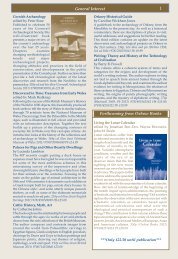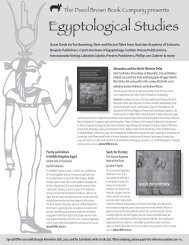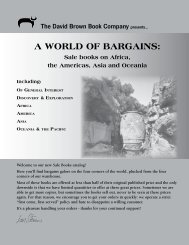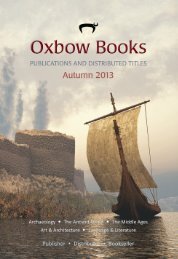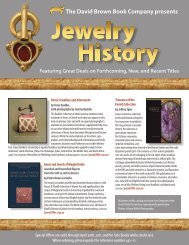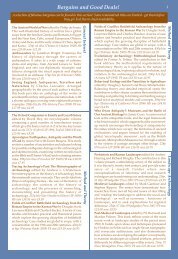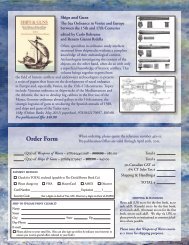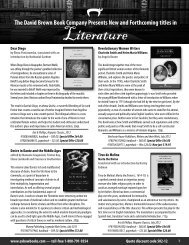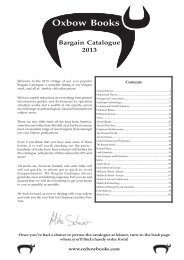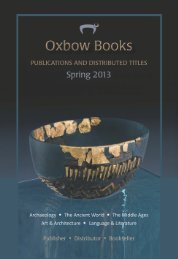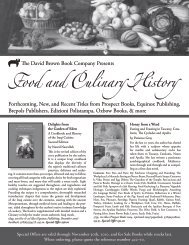MARY ROSE:YOUR NOBLEST SHIPPE
MARY ROSE:YOUR NOBLEST SHIPPE
MARY ROSE:YOUR NOBLEST SHIPPE
You also want an ePaper? Increase the reach of your titles
YUMPU automatically turns print PDFs into web optimized ePapers that Google loves.
The Preface stresses that this volume is an interim<br />
statement of what was found of the English warship<br />
Mary Rose. She was sunk in battle against the French<br />
navy on 19 July 1545, and was raised by archaeologists<br />
and engineers in 1982.<br />
Chapter 1,The Mary Rose and fighting ships by David<br />
Loades, places the Mary Rose in the context of the<br />
history of warships from Greek and Roman times to the<br />
sixteenth century. Of special importance is the<br />
significant amount of historical documentation about<br />
the ship that has been found, and the fact that the ship<br />
reflects the increasing use of heavy guns. She was built<br />
under the orders of King Henry VIII at Portsmouth in<br />
1509–1511 and soon took part in naval battles against<br />
the French in 1512 and 1513.Thereafter she was hardly<br />
used but was kept under repair between 1524 and 1530.<br />
She was originally designed for medieval hand to hand<br />
fighting, but during the 1530s she was modernised to<br />
carry a heavier armament.<br />
Chapter 2, Salvage, saving and surveying the Mary Rose<br />
by Peter Marsden, discusses the efforts to salvage the<br />
ship between 1545 and 1549. At first the Admiralty<br />
hoped to raise the ship, but found that this was not<br />
possible and only managed to raise some of her guns.<br />
Much of the salvage was undertaken by a Venetian who<br />
employed a diving team led by a west African diver. The<br />
wreck was rediscovered in 1836 and continued to be<br />
salvaged by one of the Deane brothers until 1840. More<br />
guns were found and were stored by the Admiralty at<br />
Woolwich, but other items were sold at Portsmouth. In<br />
1965 a search for the wreck was started by Alexander<br />
McKee, and in 1970 his team located a gun and a loose<br />
plank. Next year Percy Ackland found the side of the<br />
ship exposed in the sea-bed, after which the full<br />
excavation commenced. The Mary Rose Trust was<br />
formed, and in 1982 the ship was raised for preservation<br />
in a new museum in Portsmouth Dockyard. It was here<br />
that the ship began to be recorded, though this had to fit<br />
in with the conservation process. After 2000 the Mary<br />
Rose Trust received grants to complete and publish five<br />
volumes describing the ship and her contents, and also<br />
her conservation. Facilitating this was the laser scan of<br />
the ship in 2002, with the detailed recording of parts of<br />
the ship by Douglas M cElvogue that have enabled<br />
reconstructions of the vessel to be made.<br />
Chapter 3, Understanding the Mary Rose by Peter<br />
Marsden, sets out the principles by which the ship has<br />
been studied, leading to conclusions on how she was<br />
built, used, repaired and modified. Distortions to the<br />
hull were identified, and obvious missing timbers<br />
reconstructed. Crucial to reconstructing the ship was<br />
identifying her ‘plane of symmetry’ whereby the missing<br />
port side was the mirror image of the surviving starboard<br />
side. This enabled the Hold and decks to be re-<br />
Abstract<br />
xviiii<br />
constructed and furnished. Although the bow is missing<br />
the discovery of the collapsed stempost has enabled a<br />
fairly accurate reconstruction of the bow to be<br />
completed.<br />
Chapter 4, Hull design of the Mary Rose by Richard<br />
Barker, Brad Loewen and Christopher Dobbs, considers<br />
the ship as the oldest English ‘document’ on sixteenth<br />
century hull design and enables it to be compared with<br />
fifteenth century Italian texts on the subject. According<br />
to Renaissance methods, all frames were shaped<br />
according to a system of arcs with identical radii, and<br />
this influenced timber supply and frame style. The<br />
authors found that the frames of the Mary Rose followed<br />
a system of arcs, but they concluded that it was unlikely<br />
that the Italians influenced the ship’s builders. The<br />
authors believed that although there was no meaningful<br />
pattern of framing elements in the ship, the frames do<br />
fall into three groups: at the bottom of the ship, at the<br />
turn of the bilge, and at the sides.They conclude that the<br />
ship reflects a mature design process, but a youthful<br />
carvel shipbuilding industry that was less than 50 or so<br />
years old when the Mary Rose was built. It had<br />
superseded the clinker shipbuilding tradition that had<br />
existed in northern Europe for about 1000 years. The<br />
shipwright responsible for building the Mary Rose had<br />
mastered the proportional conception of the hull’s<br />
overall dimensions, conceived its master frame<br />
according to tangent arcs, and had control of the<br />
complex geometry of design. The sophisticated design<br />
methods invite questions as to their origin.Was it already<br />
in use in England during the fifteenth century, or did it<br />
come from abroad?<br />
Chapter 5, Woodworking aspects of the Mary Rose by<br />
Damian Goodburn, describes the species of timber<br />
used, mostly oak, but with some elm used in parts of the<br />
keel and on the Orlop deck. There is also a little pine,<br />
spruce and poplar used in repairs. The sizes of trees and<br />
the weights of some timbers are discussed. The<br />
construction methods of selected parts of the ship are<br />
described, including the weatherboarding in the<br />
Sterncastle, the keelson and mast-step, the deck beams,<br />
outer hull planking, knees, frames, riders, half-beams<br />
and pillars. Toolmarks and the tools that they represent<br />
are described, as well as carpenters’ marks, scarfs and<br />
joints, and treenails and iron fastenings.<br />
Chapter 6, The hull by Douglas M cElvogue, is a<br />
description of the timbers that make up the ship’s hull.<br />
They include the keel (of three timbers, elm at the ends<br />
and oak in the middle), keelson, stempost assemblage,<br />
sternpost, ‘deadwood’ (strictly not deadwood, but<br />
vertical frame ends), transom stern, frames, ceiling,<br />
stringers, gunwale, riders, brace timbers, outer hull<br />
planking, wales, caulking, seam battens, possible traces<br />
of ‘white stuff’ (a protective coating over the hull below




